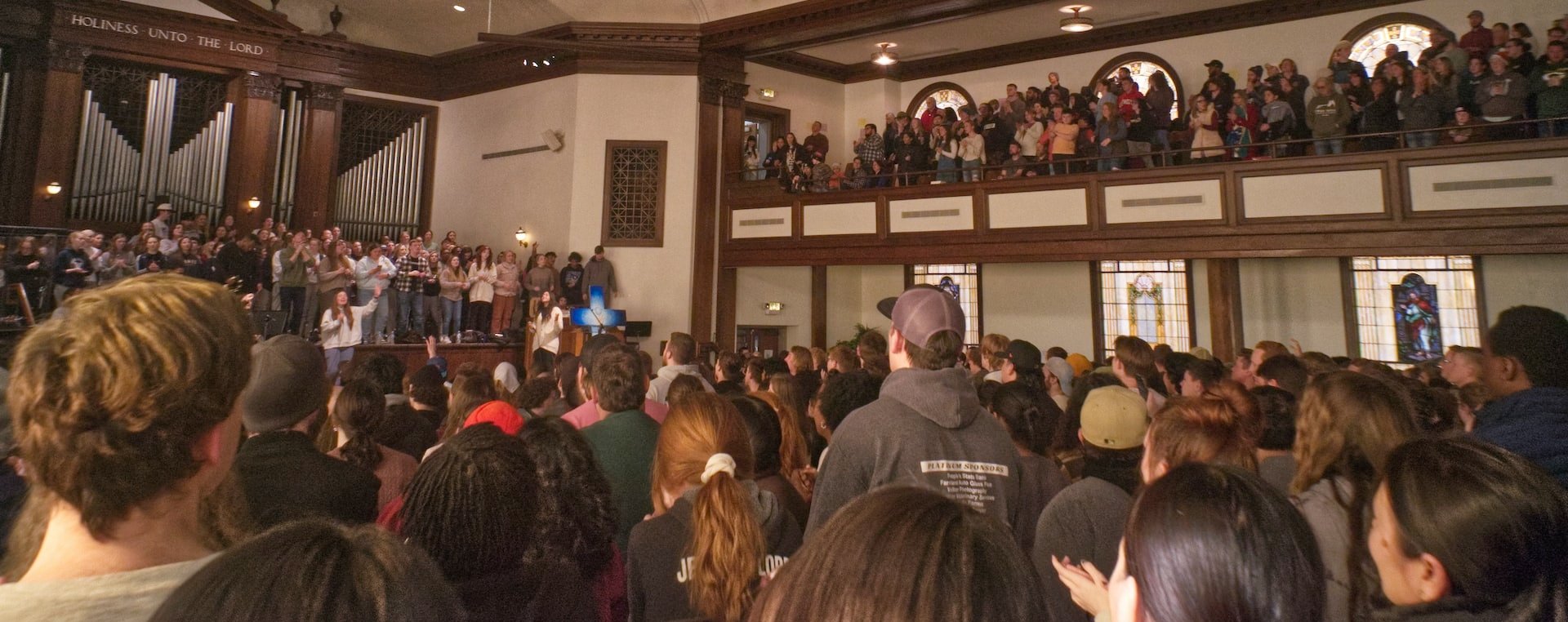THE ASBURY “REVIVAL” 2023— What do true followers of Christ need to understand about what really happened, and where it may lead?
Asbury University is a private Christian liberal arts university in Wilmore, Kentucky affiliated with the Wesleyan-Holiness movement. Chapel attendance is mandatory for students on certain weekdays. On Wednesday, February 8, 2023, a handful of students remained in the chapel following a regularly scheduled service. This continuation of the service continued in various degrees through February 24. Due to widespread publicity, tens of thousands of curious visitors came to the campus from throughout America and from other nations to see for themselves what was happening and/or to participate. There were reportedly 50,000-70,000 participants overall. The event has also been called the “Asbury Outpouring” and “Asbury Awakening.”
American schools certainly do desperately need a major awakening to the Gospel of Jesus Christ, a honest sense of individual shame and guilt for their many sins witnessed by our holy Creator, followed by true repentance for all sins, and a full commitment to believe and follow Christ and His Word, resulting in regeneration (new birth), eternal life and salvation from eternal separation from God.
But does what happened at Asbury in 2023 truly fit this description of what we are yearning for?
A much deeper, more thorough examination by scholars…
Further information
- “Asbury Revival and the Local Church” by Josh Buice, founder and president of G3 Ministries
- “Unbiblical Expectations of Revival” by Scott Aniol, PhD, Executive Vice President and Editor-in-Chief of G3 Ministries
The Great Awakening in New England occurred from 1734-49 and was truly great and very different than what happened at Asbury in 2023. It is also called the Evangelical Revival. In America one of its most effective preachers was Jonathan Edwards whose most famous sermon is titled, “Sinners in the Hands of an Angry God.” He emphasized the reality of Hell, the true depravity of mankind (by nature, spiritually “dead in sin”), the need for a deep personal conviction of one’s desperate need of salvation by Jesus Christ, justification by faith alone, and commitment to a Biblical standard of personal morality and purity—stressing that conversion is not only an intellectual assent to correct Christian doctrine but it requires a “new birth” experienced in the heart. He also taught receiving assurance of salvation was a normal expectation in the Christian life.
The process was in three stages. The first stage was true conviction of sin, which was spiritual preparation for faith by God’s law and the means of grace. The second stage was conversion, in which a person experienced spiritual illumination, repentance and faith. The third stage was consolation, which was searching and receiving assurance of salvation. This process generally took place over an extended time.
Evangelical preachers “sought to include every person in conversion, regardless of gender, race, or status.”
The result: Signs of religious commitment among the lay people increased, especially among the town’s young people. Edwards wrote to Boston minister Benjamin Colman that the town “never was so full of Love, nor so full of Joy, nor so full of distress as it has lately been. …I never saw the Christian spirit in Love to Enemies so exemplified, in all my Life as I have seen it within this half-year.”
The Awakening unleashed a strong impulse towards interdenominational unity among the various Protestant denominations. Evangelicals considered the new birth to be “a bond of fellowship that transcended disagreements on fine points of doctrine and polity,” allowing Anglicans, Presbyterians, Congregationalists and others to cooperate across denominational lines. …evangelicalism became more mainstream.
In contrast, the so-called Second Great Awakening (1790-1845) was not so great from a Biblical point of view and is more similar to what happened at Asbury. It began in Kentucky and Tennessee. Presbyterian Charles Grandison Finney was the most prominent and passionate leader. He rejected much of traditional Reformed theology, including traditional Calvinist theology, taught that one could lose their eternal salvation, and strongly promoted social reforms—urging his listeners to work to build the kingdom of God on earth, because Finney’s eschatology was post-millennial—believing that the Millennium (a thousand-year reign of Christ on Earth) would begin BEFORE Christ’s Second Coming.
Finney had women pray out loud in public meetings of mixed sexes, the introduction of the “anxious seat” in which those considering becoming Christians could sit to receive prayer, and public censure of individuals by name in sermons and prayers. He was also known for his extemporaneous preaching, rather than strong expositional teaching of the Bible. Rather, the resulting revival meetings were characterized by high enthusiasm, strong appeals to emotion, and the promise of supernatural manifestations.
- “The Asbury Revival: Is it Real?” Jon Harris (author of Social Justice Goes to Church) talks to Kentucky pastors Jerry Dorris and Austin Keeler about their experience at the “Asbury Revival”
- What is a TRUE BIBLICAL CHRISTIAN?
- What is the Holy Spirit?
- GAY—What’s wrong with being Gay? Answer —Homosexual behavior versus the Bible: Are people born Gay? Does homosexuality harm anyone? Is it anyone’s business? Are homosexual and heterosexual relationships equally valid?
- What about Gays needs to change? Answer —It may not be what you think.
- What does the Bible say about same sex marriages? Answer
- Can a Gay or lesbian person go to heaven? Answer —If a homosexual accepts Jesus into his heart, but does not want to change his lifestyle, can he/she still go to Heaven?
- “God made me like this. Sin is His fault!” Response
- “God made me Gay!”
- Read stories about those who have struggled with homosexuality
